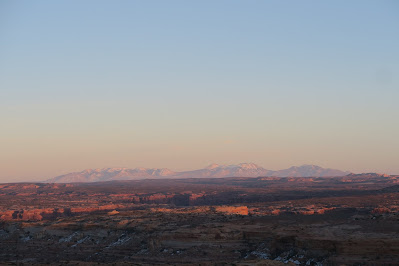Colonnade Arch. Really cool arch!
I had never heard of Colonnade Arch or Labyrinth Canyon Wilderness. During some search for hikes in our 2024 Winter trip in Utah, this came up and we gave it a try after a big hike, which was Holy Ghost Panel hike in Horseshoe (Barrier) Canyon in Canyonlands National Park.
Colonnade Arch hike is only 2.3 miles with less than 200 feet elevation change, so it was nice to add to a big hike to conclude a day. Holy Ghost Panel Hike was no any other person, and after that, no single car or a person to the trailhead of Colonnade Arch, and during hike absolutely nobody else. Perfect solitude day!
The hike is pretty straightforward. Relatively flat trail until a little before arch. The view is gorgeous and massive. You see the vast Utah's world with magnificent mountain range in the distance as below picture.
It is already rewarding of this view, but this is just one of many great scenery. Of course another big highlight is the Colonnade Arch. Every arch is unique. This one has continuous arch together as you see in the below picture. So cool, isn't it? The arch even exists behind in the back of first layers of arch. People don't know much about the fact there are so many cool arches in addition to Arches National Park, for example in American Southwest.
It is fun exploring under the arch as well. The bottom picture is now looking the canyon view from the arch. Priceless view. Because it was evening, the sun was going down and every minute the lightning was changing. It was warm orange sunshine hitting the rock. That makes the rock color really beautiful.
When we came back to the trailhead, the sunlight got really orange and the scenery was different than the time we started (you can compare with the first picture). What a bonus.
It is already rewarding of this view, but this is just one of many great scenery. Of course another big highlight is the Colonnade Arch. Every arch is unique. This one has continuous arch together as you see in the below picture. So cool, isn't it? The arch even exists behind in the back of first layers of arch. People don't know much about the fact there are so many cool arches in addition to Arches National Park, for example in American Southwest.
When we came back to the trailhead, the sunlight got really orange and the scenery was different than the time we started (you can compare with the first picture). What a bonus.












































